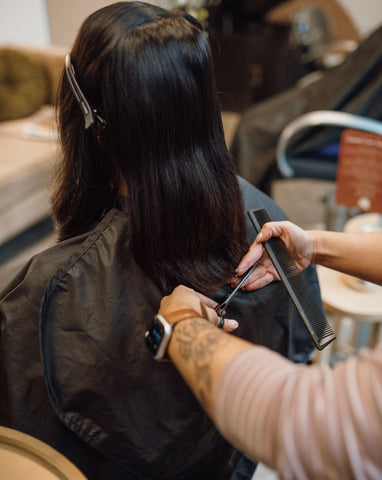When we learn to cut hair, we learn to get the whole haircut wet and we learn one technique dry and that's to point cut. Once we get on the floor cutting a client's hair, you might learn or find new ways of cutting hair differently to what you learnt in Tafe by other trainers or hair stylists in your salon.
Really there is no one way of cutting hair but there are some principles that stay the same. By cutting differently to another hairstylist doesn't make it wrong, it makes your skills as a hairstylist unique and by being unique that can attract your own unique kind of clientele.
Really, cutting comes down to confidence in how you're cutting and cutting to create the best results for your client and what hairdresser scissors you use.
So let's go through some popular or unpopular opinions about wet or dry hair cutting. Some facts you may agree with others you simply may not because you like your way better and hopefully some facts may spark you to try or learn from.

What is the difference between wet and dry cutting
What is the difference between wet cutting or dry cutting hair? Apart from the obvious point that hair has to be wet or dry, we think that some techniques are better when cut wet or dry.
We will go through that difference for you now.
Cutting Wet Hair
- When cutting a restyle cut, cutting the length and layers into the hair is the most precise and easy way to cut in the bulk on the hair cut, which is a plus.
- If you are a hairstylist that loves razor cutting hair then you would know that this would need to be done only with wet hair.
- Hair will be stretched out and perfect when wet which can be a good or bad thing. Good for a precise haircut, Bad for any cowlicks or crowns that may unexpectedly spring up creating holes in the haircut when dry rather than wet cutting.
- When cutting hair wet it's so important to do a consultation dry first to see how the hair naturally sits and checking for those pesky cowlicks.
- Water does weigh down the hair so when cutting a whole haircut wet can sometimes be a disadvantage and you could potentially cut the hair too short in some areas, which will result in you having to cut more hair off when the hair is dry to fix any mistakes.
- Less is more when wet cutting, why? because you can always take more off if you need to when the hair is dry, but you cannot put the hair back on if you got scissors happy when the hair was wet.
- It is not recommended to use thinning scissors or texturizing scissors on wet hair because you could easily make the mistake of taking too much off or creating lines in the hair.

Dry cutting hair
- Dry cutting a haircut from start to finish can work best in circumstances where cutting curly and wavy hair. Cutting the hair dry is best in these circumstances because you can see a curl's natural form of how the curl sits when dry.
- Point cutting, blending, and finishing off the haircut is best done when the hair is dry and styled.
- Dry cutting helps to create a robust line and helps create a more natural shape.
- Cutting the hair all dry is a faster way to cut your clients hair.
- Dry cutting is best for those clients with prominent cowlicks and growth patterns that create unwanted volume in a certain area. If you have a client with lots of cowlicks it's recommended to not use too much tension with your comb while cutting so you don't create holes in the haircut.
- Dry cutting is best when the hair is freshly washed and dried off. If you cut dry hair dirty then you risk the hair falling completely different when freshly washed.
- Dry cutting works best for cutting in fringes, trimming a fringe or softening and cutting in shape around the face. Slide cutting scissors around the face works best when the hair is dry.
- Fine hair is cut better when dry so you can see the hair texture and thickness of the hair.
- If you have a client with damaged hair we recommend cutting it dry so you can see the split ends that need to come off. Also combing damaged hair when it's wet can damage the hair more.

We believe that you don't always have to do a wet haircut or a dry haircut because every circumstance may be different. You may learn a way that works for you and you feel comfortable sticking to that, all new techniques may open your mind to try cutting all different kinds of ways.
There's no right and wrong answer here as long as you can get the same result from a dry haircut or a wet haircut, but what you don't want is to make a mistake due to cutting the hair wet or dry.
Whether you like to cut hair wet or leave the hair natural and cut to dry, these are all assessments you can make during an extensive consultation with your client. Because going through the best consultation with your client gives you time to access and cowlicks, damaged hair, an uneven haircut and your client may be able to tell you errors other hairdressers have made with their hair before which will help you provide the best service.


